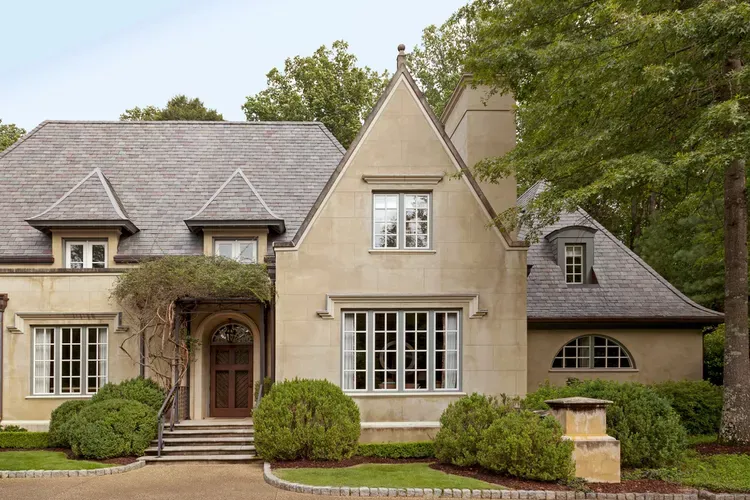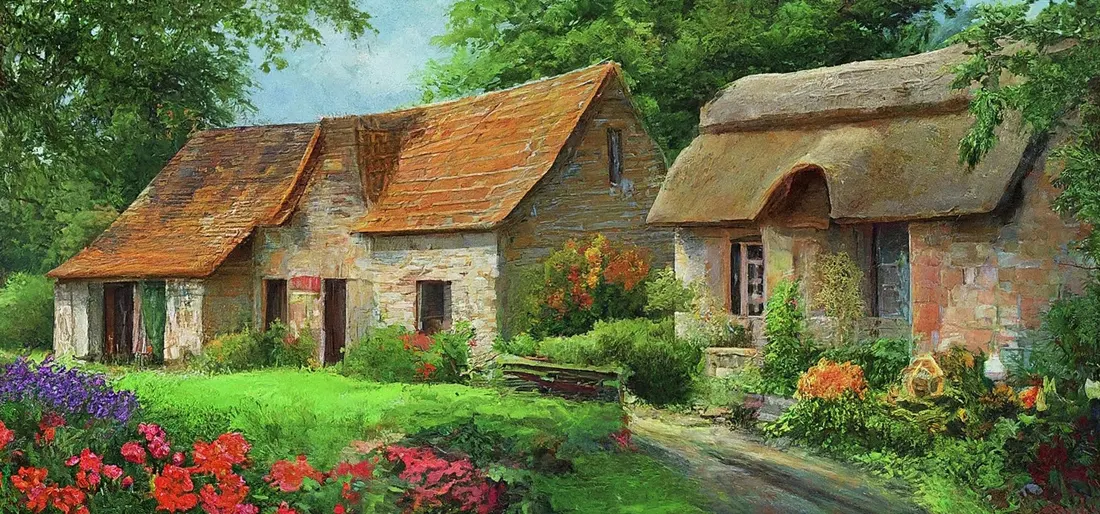Embracing the Charm of French-Country Architecture
Everything you Need to know about the French-Country Architecture
Ever dreamt of living in a charming French-Country house with beautiful stone walls and a rustic ambiance? Well, that dream can become a reality with the French-country architectural style! This style is all about blending elegant and stylish French sophistication with cozy countryside components. From exposed wooden beams to steeply pitched roofs, French-Country houses have a unique charm that is hard to resist.
So, in architectural beauty, few styles capture the essence of rustic charm and timeless elegance quite as French-Country architecture does. With its picturesque landscapes and quaint yet genuine villages, France has long been celebrated, and famous for its captivating blend of old-world allure and pastoral simplicity.
If you're curious about this architectural style and want to learn more about what sets it apart from the rest, keep reading to discover the beauty of French-Country architecture!
 |
| Traditional French-Country architectural style featuring steeply pitched roofs and dormer windows, Photo: bhg.com |
Having said that, what are you waiting for? Because, in this blog post, we'll embark on a beautiful journey through the enchanting world of French-Country houses, exploring their unique features, rich history, enduring appeal, and everything in between you need to know about it!
Emergence, Origins, and History of the French-Country Architectural Style
The emergence and history of our style are deeply interlaced with the cultural, geographical, and historical evolution of France itself. Rooted in the rural landscapes and regional traditions of the French countryside, this architectural style has undergone a fascinating journey of development over the centuries.

Follow the latest developments and news on our Google News website.
Follow Our WebsiteOrigins
It traces its origins back to the 17th and 18th centuries, a time when France was undergoing significant social, political, and cultural transformations. As the power of the monarchy expanded and feudalism waned, a burgeoning middle class began to emerge, seeking to establish their own distinct identities through architecture and lifestyle.
Regional Influences
One of the defining characteristics of French-Country architecture is its regional diversity, with each province of France boasting its own unique style and aesthetic sensibility. From the sun-drenched landscapes of Provence to the lush green pastures of Normandy, the architectural heritage of France is a tapestry woven from a rich array of influences and traditions.
 |
| Old traditional French-Country houses, generated by AI |
In Provence, for example, the warm Mediterranean climate and abundant natural resources shaped the architectural vernacular, giving rise to homes characterized by sun-drenched terraces, terra cotta roofs, and vibrant shutters.
In Normandy, on the other hand, the cooler climate and abundant timber resources led to the development of half-timbered houses with thatched roofs, reflecting the rustic charm of the countryside.
Influential Periods and Movements
The style prospered during the reign of Louis XIV, whose passion for art and culture inspired a renewed interest in the rural landscapes and rustic traditions of France. It was during this period that the iconic elements of French country houses, such as steeply pitched roofs, dormer windows, and exposed timber beams, began to take shape.
The 19th century saw a revival of interest in French country architecture, fueled in part by the Romantic movement and a growing nostalgia for simpler times. Architects and designers drew inspiration from rural motifs and rustic materials, creating homes that celebrated the beauty of the French countryside while embracing modern comforts and conveniences.
In the 20th century, it experienced a renaissance of sorts, as designers and homeowners sought to capture the timeless elegance and pastoral charm of the style. Influential figures such as architect Le Corbusier and designer Gustave Eiffel drew inspiration from the rustic traditions of France, incorporating elements of French-country architecture into their innovative designs.
Understanding and Defining French-Country Architecture
French-Country architecture, also known as French Provincial or Provencal architecture, is characterized by its rustic yet refined aesthetic inspired by the rural countryside of France. Originating in the 17th and 18th centuries, this architectural style reflects the regional traditions and cultural influences prevalent in various provinces of France.
One of the defining features of those stylish houses is their asymmetrical façades, often adorned with charming details such as steeply pitched roofs, dormer windows, and exposed timber beams. These elements contribute to the overall romantic and whimsical appeal of the architecture, evoking a sense of warmth and hospitality.
It is important to note at this point, that while both French Provincial and French-Country design styles share some similarities due to their French roots, they are different; Many people often need clarification on these two French styles, thinking they're the same. But in reality, they're quite distinct! Read more in "Revealing the Distinction: French Provincial vs. French-Country Design!"
🛈 We'll also get into more detail about the topic in the section below.
Exploring the Components of French-Country Houses
Rooflines and Materials
A hallmark of French-Country architecture is the use of distinctive rooflines, typically featuring steep slopes and overhanging eaves. This design not only adds visual interest to the exterior but also serves a practical purpose by providing protection from the Elements. Common roofing materials include clay tiles, slate, or thatch, further enhancing the homes' rustic charm. Read more >>
 |
| Typical French-Country architecture style, featuring roof and gable dormers, Photo: theplancollection.com |
Windows and Doors
Windows play a crucial role in this kind of country house, serving as both functional openings for ventilation and sources of natural light. Traditional windows are often multi-paned with wooden frames and garnished with shutters for added character and charm. Similarly, doors are crafted from solid wood and may feature decorative accents such as wrought iron hardware or arched entrances.
Materials and Textures
The use of natural materials is a central theme in French-Country architecture, reflecting a harmonious relationship with the surrounding landscape. Stone, brick, and stucco are commonly used for exterior walls, imparting a sense of solidity and permanence to the homes. Interior surfaces often showcase exposed wooden beams, rough-hewn stone, and plaster walls, creating a tactile and inviting atmosphere.
Interior Layout and Design
French country houses are known for their cozy and welcoming interiors, characterized by an effortless blend of rustic elegance and comfort. Open floor plans and flowing layouts encourage a relaxed and casual lifestyle, with spacious kitchens and inviting living areas serving as the heart of the home. Warm color palettes, soft textiles, and antique furnishings add to the overall ambiance, creating a sense of timeless beauty and tranquility. Read more >>
Regional Variations and Influences
While this architecture shares common characteristics across different regions of France, there are notable variations influenced by local traditions and cultural heritage. For example, in the Provence region, houses may feature sun-drenched terraces, vibrant shutters, and fragrant gardens filled with lavender and olive trees. In contrast, homes in the Normandy region might boast half-timbered facades, thatched roofs, and bucolic countryside vistas.
The Enduring Appeal of French-Country Architecture
Despite evolving trends and changing tastes, French country architecture continues to captivate homeowners and designers alike with its timeless allure and enduring charm. Whether nestled amidst rolling vineyards, nestled along picturesque coastlines, or tucked away in quaint villages, these homes exude a sense of romance and authenticity that transcends generations.
Country vs. Provincial: Unveiling the Differences!
While Country and Provincial styles are both inspired by the rustic charm and elegance of the French countryside and province, there are some differences between the two. In detail, here's what those distinctions are:
1. Origin and Influence:
- Country style, also known as "French farmhouse" or "French cottage" style, draws inspiration from the rural regions of France. It embodies a relaxed, rustic, and cozy aesthetic with elements like natural materials and earthy tones.
- Provincial style, on the other hand, refers to the furniture and interior design trends that originated in the provinces of France during the 17th and 18th centuries. It reflects the tastes of provincial nobility and the bourgeois, featuring more refined and ornate furniture and décor compared to the simpler French-country style.
2. Color Palette:
- Country style often incorporates a soft, muted color palette inspired by nature, including shades of white, cream, beige, soft pastels, and muted earth tones.
- Provincial style tends to feature a more diverse color palette, including rich and bold hues such as deep blues, greens, and reds, often complemented by soft neutrals.
3. Furniture Design:
- French country-style furniture is typically more rustic and casual, featuring distressed finishes, natural wood tones, and simple lines. It often includes farmhouse-style elements like ladder-back chairs, trestle tables, and cabinets with open shelving.
- French provincial furniture is characterized by its elegant and refined appearance, with more intricate carvings, curves, and decorative details. Pieces may include cabriole legs, scalloped edges, and ornate hardware. Read more >>
4. Textiles and Patterns:
- In French country style, textiles often feature natural fibers like linen and cotton, along with simple patterns such as checks, stripes, and floral motifs.
- French provincial interiors may incorporate luxurious fabrics like silk and velvet, with more elaborate patterns such as toile, damask, and intricate floral designs.
5. Accessories and Décor:
- Country style emphasizes a casual and lived-in look, with an abundance of natural elements like exposed wood beams, stone floors, and woven baskets. Decorative accents may include vintage pottery, floral arrangements, and botanical prints.
- Provincial décor tends to be more formal and sophisticated, with refined accents like gilded mirrors, crystal chandeliers, and porcelain figurines. It may also include classical architectural elements like cornices, moldings, and pilasters.
While both styles share some common elements and evoke a sense of timeless elegance, the French country style leans towards a more casual and rustic aesthetic, while the French provincial style embodies a more formal and refined elegance.
.png)






